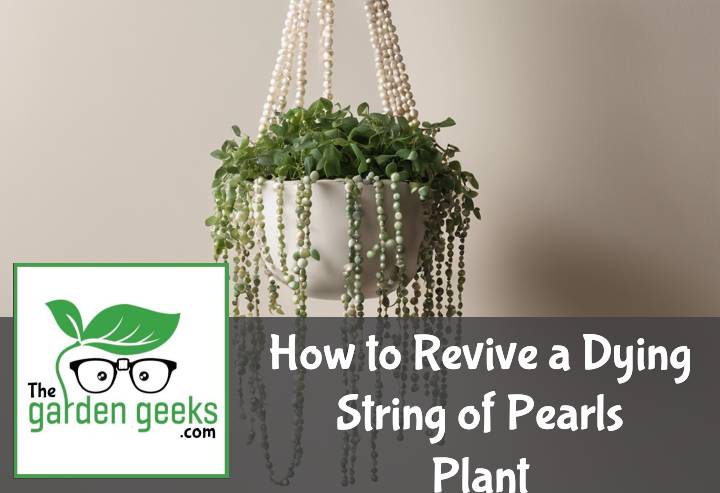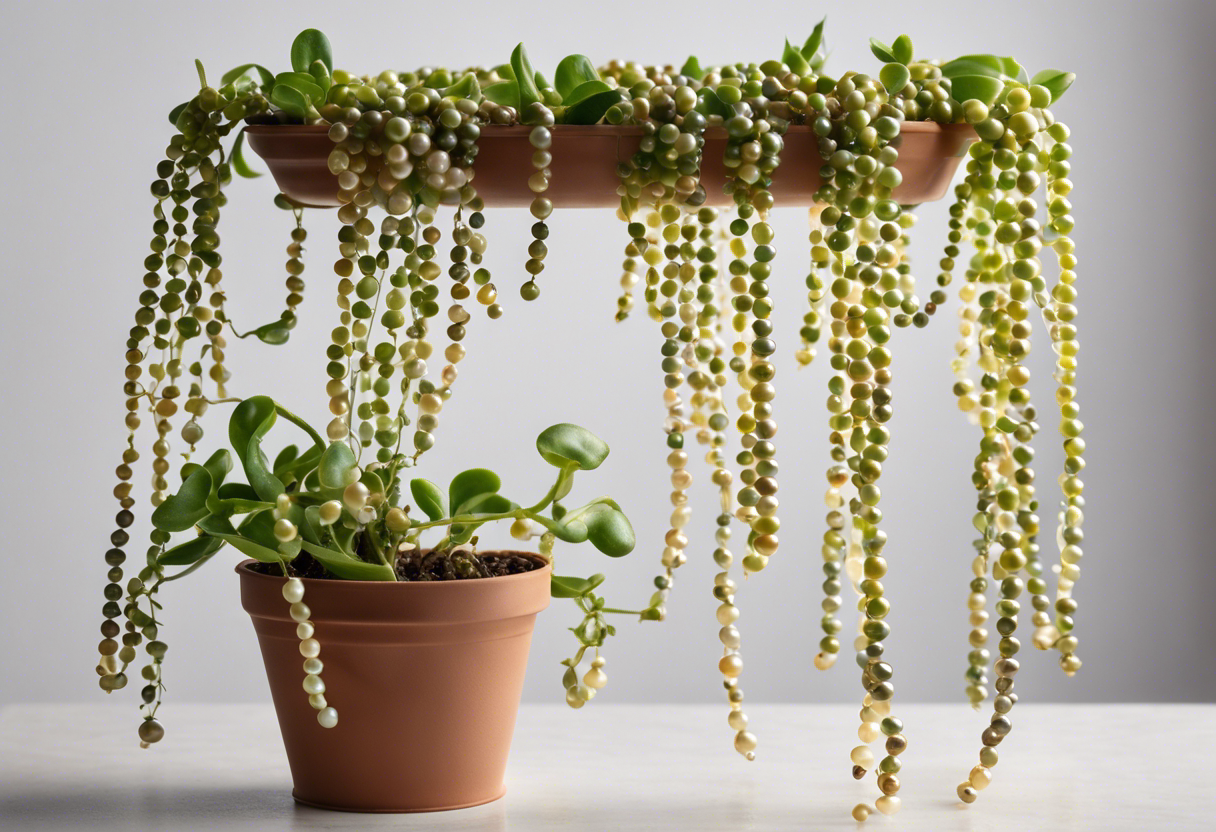Ever had a moment of panic seeing your beloved String of Pearls plant looking more like a string of peas? I’ve been there, trust me. But don’t fret! How to Revive a Dying String of Pearls Plant is not as hard as it may seem.
In the next few lines, we’ll unravel this mystery together. So grab a cuppa, get comfy and let’s dive into the world of these pearly wonders! Keep reading about How to Revive a Dying String of Pearls Plant.
Key Takeaways
- Identify signs of a dying String of Pearls plant, such as shriveled or discolored pearls.
- Overwatering is a common cause; ensure the plant has good drainage and water only when soil is dry.
- Provide indirect sunlight; too much direct sun can burn the plant.
- Repotting may be necessary if roots are rotting. Use fresh, well-draining soil.
- Prune dead parts to encourage new growth.
- Maintain room temperature between 70°F – 80°F for optimal health.
Understanding the String of Pearls Plant
The String of Pearls plant is a unique gem in the world of succulent plants. It’s a darling among indoor gardening enthusiasts, thanks to its distinctive features and easy houseplant care requirements.
What is a String of Pearls Plant?
The String of Pearls plant, scientifically known as Senecio rowleyanus, is a popular succulent species. Its name comes from its round leaf succulent that looks like peas strung together, making it an ideal trailing houseplant or hanging basket plant.
This plant originates from South Africa and has adapted to survive in arid conditions. It’s loved by many for its whimsical appearance and low-maintenance nature.
The Ideal Environment for a String of Pearls Plant
To keep your String of Pearls happy and healthy, you need to mimic its natural environment. This means providing plenty of bright but indirect light. Yes, the indoor light requirements are crucial!
Next up is temperature – these plants prefer it warm! An optimal temperature for succulents like this one is between 70-80°F during the day and not below 50°F at night.
Humidity? Not so much! These desert dwellers prefer drier air. However, when it comes to watering your string of pearls, remember: less is more! Overwatering can lead to root rot. And lastly, they love well-draining soil – your typical soil type for succulents will do just fine.
Common Problems with String of Pearls Plants
Despite being relatively easy to care for, there are some common issues you might encounter with your String of Pearls plant. One major culprit? Overwatering! Yup, overwatering succulents like this one can cause root rot and yellowing leaves on string of pearls.
Another common problem is pest infestation in houseplants. Keep an eye out for mealybugs and spider mites, as they love to snack on these succulents. And if you notice your plant drooping, it might be due to insufficient light or too much water.
Remember, How to Revive a Dying String of Pearls Plant starts with understanding the plant itself and its needs. So keep these tips in mind and your String of Pearls will thrive!
Identifying Signs of a Dying String of Pearls Plant
If you’re wondering how to revive a dying String of Pearls plant, the first step is to identify the problem. Let’s look at some common String of Pearls plant problems and signs that your succulent might be in distress.
Discoloration and Wilting
When your String of Pearls starts changing color or wilting, it’s waving a red flag. A healthy plant should have vibrant green pearls. If you notice any succulent color changes like yellowing or browning, it’s a sign of an unhealthy String of Pearls.
Wilting is another symptom to watch out for. Your pearls should be plump and firm, not shriveled or soft. If they start looking more like raisins than grapes, it’s time to take action.
Root Rot and Overwatering
Overwatering is one of the most common causes of dying succulent signs. It can lead to root rot, which is pretty much a death sentence for your plant if not addressed promptly.
An overwatered String of Pearls will have mushy, brown roots instead of firm white ones. To avoid this issue, water your plant sparingly and make sure it has good drainage.
Pests and Diseases
Pests and diseases are other culprits that can turn your healthy String of Pearls into a sickly one. Common pests include mealybugs and aphids, while fungal infections are also quite common.
Early detection is key when dealing with these issues. Look out for signs like small cottony patches (mealybugs) or black sooty mold (aphids). As soon as you spot any trouble, get your plant treated pronto!
Reviving Your Dying String of Pearls Plant
Hey there, plant lover! So, your String of Pearls plant is looking a bit under the weather? Don’t fret! Reviving dying plants, especially succulents like this one, isn’t as hard as you might think. With some indoor plant revival tricks and proper String of Pearls plant care, we’ll have your green friend back to its glorious self in no time.
Adjusting Watering Practices
First things first – let’s talk about water. You see, these little guys can be quite fussy when it comes to hydration. Overwatering or underwatering can lead to a sad-looking String of Pearls.
Overwatered plants often show signs like yellow leaves and root rot. On the other hand, underwatered ones may have shriveled leaves. So, what’s the sweet spot? Well, for optimal watering for String of Pearls, wait until the soil is completely dry before giving it a good soak.
Modifying Light Conditions
Next up on our houseplant recovery mission – light conditions. Too much sun can scorch your plant while too little can stunt its growth. It’s all about balance here!
Your String of Pearls needs bright but indirect sunlight to thrive. If you’ve been keeping it in a dark corner or directly under harsh sunlight, that could be why it’s not doing so well.
Repotting and Soil Changes
Finally, let’s get down and dirty with repotting and soil changes! Sometimes, all a plant needs is a fresh start in new soil or a bigger pot.
If your String of Pearls has outgrown its current home or the soil has become depleted of nutrients, repotting might just do the trick. Choose well-draining soil designed for succulents to give your plant the best chance at recovery.
And there you have it, folks! A quick guide on how to revive a dying String of Pearls plant. Remember, every plant has its own personality and needs, so keep an eye on your green buddy and adjust care practices as needed. Happy gardening!
Preventive Measures to Keep Your String of Pearls Healthy
In the journey of How to Revive a Dying String of Pearls Plant, prevention is better than cure. Taking preventive measures for plants can save you from the heartache of seeing your beloved String of Pearls wilt away. Let’s dive into some preventive measures that can help in maintaining plant health, especially focusing on our green friend, the String of Pearls.
Regular Monitoring and Care
One key aspect in String of Pearls care is regular monitoring. Just like you’d check on your pet or a baby, your plant needs attention too. Regular plant monitoring helps you catch any signs of distress early on. This way, you can prevent plant decline before it gets serious.
Now, caring for String of Pearls isn’t rocket science but it does require consistency. A simple succulent maintenance routine involves checking its soil moisture levels and ensuring it’s getting enough light. Remember folks, indoor plant check-ups are as important as your own!
Proper Feeding and Fertilization
Moving on to another crucial part – feeding and fertilization! Yes, plants eat too! Proper plant feeding practices are essential for their growth and health. And when we talk about fertilizing String of Pearls, less is more.
These succulents have modest nutrition needs compared to other indoor plants. So overdoing with the indoor plant fertilizer use might do more harm than good. The right balance promotes plant longevity and keeps them happy.
Pest Control Measures
Last but not least, let’s talk about pest control for plants. Those tiny bugs might seem harmless but they can wreak havoc on your precious String of Pearls if left unchecked.
There are several ways to protect your String of Pearls from pests – from using organic sprays to introducing beneficial insects that prey on common houseplant pests (yes, nature has its own pest control!). Prevention methods are always better than dealing with a full-blown infestation. So, keep an eye out for those pesky bugs!
To Wrap Up
Just like a superhero reviving their sidekick, we’ve walked you through How to Revive a Dying String of Pearls Plant. And it’s not rocket science, folks! Just the right amount of sun, water and TLC.
So go on, don’t let your green buddy bite the dust. Unleash your inner plant whisperer and bring those pearls back to life!





